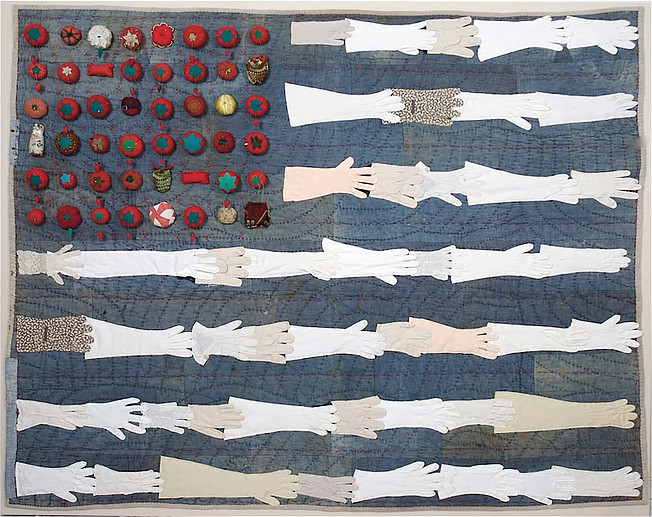Mantle of Iniquities
Found objects are what Marianne Lettieri calls, “physical evidence of human preoccupation and temporality.” This speaks to the artist’s twenty-two years spent in the world of dance and choreography merged with her pursuit of fine art. Pieces of Lettieri’s sculptures are haunted by their past connection to a human being, like the steps and movements of a dance.
“I’m always looking for that point where a functional object becomes a catalyst for reflection on self and society,” says Lettieri. Lettieri’s work deals with many themes, gender among them. A flag whose stripes are made up of lady’s gloves and pin cushions is titled “Old Glory.” “Skeins of Time” features neat bundles of twine that are stacked uncomfortably into a cage, touching every bar that holds them in place. Of this meeting of the past with present insight, Lettieri says, “The impetus for my art-making is to present castoff materials in new aesthetic configurations that illuminate current contexts.”
Other sculptures leave an eerie, dreamlike impression. A wooden cradle holds but glass orbs as if they are symbols of the lives that once slept there (“Cradle with Bedrock”). It rests on bedrocks covered in dainty crochet webs. “The Dream and Stare Upon Roving Sky” a doll-sized wooden house that floats on the skeleton of an antique baby carriage. Old photos of faces fill the windows.
Old Glory
What is compelling about found objects is that they exude a strong sense of memory, even though the person looking at them has no connection to the thing itself. “Objects have stories to tell. My role as an artist is harnessing those voices to my own purposes,” says Lettieri, manipulating each element so that as a whole they represent her narrative. “Mantle of Iniquities” began as a theatre curtain that Lettieri found on a construction site. It is shaped like a “Medieval surplice or liturgical tunic” and woven with pop cultural objects. The artist is telling a story about perversion in the most expectedly pure places. “The rich tapestry of red objects is alluring until we notice the roaches and reptiles commingling with the artifacts of our lives,” she says. “It also calls to mind Biblical references to Christ as a sacrifice for the world’s iniquities.” The color red, the saturation of the hue in the fabric and objects, speaks to the blood that was shed at the crucifixion. Lettieri’s use of a theatre curtain is also a strong reference. As Jesus was killed the curtain of the temple was torn, opening up a space that only the highest of human priests was allowed to enter. Christ’s sacrifice allowed humanity to have access to God without the intercession of an appointed human priest. Knowing Christ took the place of the intercessor.
“Much of my art re-contextualizes discarded everyday objects and frames them in religious architectural forms.” Once framed, “the artifact is made worthy of contemplation, becoming a window into the inner world as the viewer projects onto it personal experiences.” Lettieri’s installation “Emptied and Consumed” featured jars from her own kitchen and those of her neighbors. “Presented as an altar, the installation of silvered glass food jars and candles wryly comments on life energy devoted to food preparation and consumption.” The history of the hutch is distinct from her usually found materials. “It probably had been in [my grandmother’s] kitchen during the Great Depression when she was glad to have a job in a Southern textile mill. She kept the cupboard filled with home-canned fruits and vegetables that she picked from her garden and shared generously with neighbors. It is a symbol of hard times and giving joyfully out of poverty.” The exhibition was sponsored by the non-profit Spark and Echo. “The work was temporarily installed in a historic rural chapel in Northern California. Placed in a worship space the work evokes an altar spilling forth its treasure of sacred vessels. I like to think it calls attention to the spiritual in the everyday.”
Lettieri is currently teaching a mixed media art class for adults at The Community School of Music and Arts in Mountain View, CA. The focus of her Mixed Media Mayhem class is “to disrupt the way we always do our art. Perfection is discouraged! So everyone is having a good time being free, taking risks, experimenting, and trying new things.” This includes the use of found natural objects and manipulating of common drawing tools to make the creative process less familiar and expected. “This week we’re layering paper and paint on wood and sanding through with industrial sanders.” By teaching this workshop Lettieri is able to share the magic that she finds in mayhem, “I guess all the different techniques could be overwhelming, but somehow it all comes together in their final projects.”
Learn more at Mariannelettieri.com
Emptied and Consumed









Leave A Comment